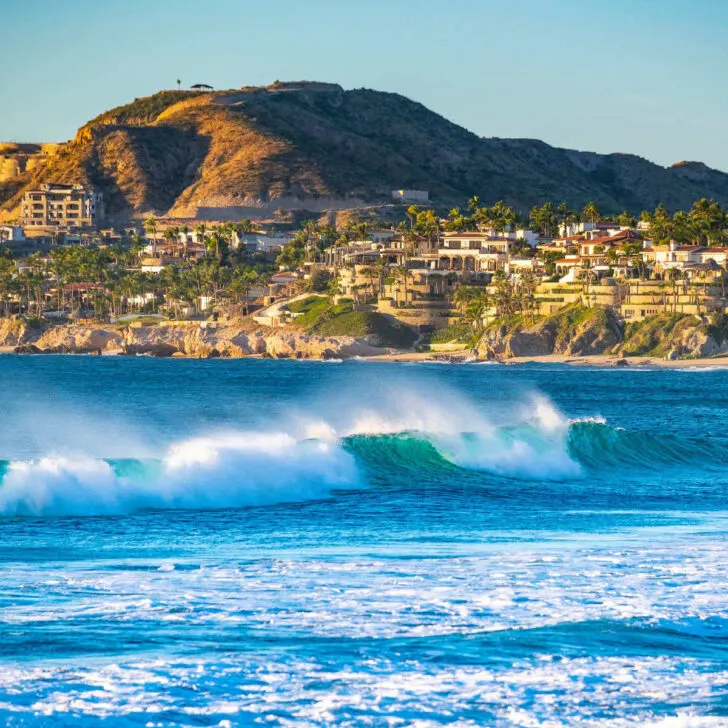Other than the incredible food, hospitable locals, world-class resort stays and unbeatable balmy weather, one of the many reasons why Americans flock into Los Cabos in Mexico is the sun-kissed coast lapped by azure waters.
That’s why some travelers are often surprised to find that several beaches are off-limits due to the impossibly-tall waves and unpredictability of the Pacific––we know, pretty ironic, right?
It’s simply not pacific enough to be in.
This has always been an issue in Cabo, but if the number of red flags dotting the oceanfront is anything to go by, tourists should now be careful in most swimming spots:
Why Are Beaches In Los Cabos More Dangerous?
Contrary to popular belief, probably derived from the naming itself, the Pacific isn’t exactly the least choppy of oceans: as the distance over which the wind blows, called a ‘fetch’ in technical terms, is greater on the West Coast of the Americas, contributing to the size of waves.
Think of it as a snowball: the farther back you roll it, the bigger that snowball gets, and the same goes for waves, so once they crash against the shoreline somewhere lie Cabo, which (mostly) straddles the open Pacific, they’re far more sizable and lengthier.
This means it’s far more common to experience big waves on the Pacific Coast of Mexico, particularly the southern tip of Baja California Sur, where Cabo is located, than Cancun, Playa Del Carmen and the like, that sit on the Caribbean Coast instead.
This past week, the presence of winds with a speed ranging from 10 to 12 km/h led ZOFEMAT, a Spanish acronym for Municipal Coordination of the Federal Maritime Terrestrial Zone, to place warning flags on a number of Cabo beaches, including the entirety of the Tourist corridor.
Which Beaches Are Safe For Swimming?
Because of this phenomenon, countless beaches along the Los Cabos strip are now playing host to both yellow and red flags.
In case you’re unfamiliar with them, yellow indicates swimmers should be ‘extremely cautious’ in the water, as there may be strong undercurrents occurring with little to no warning, while red means they should steer clear of the ocean altogether.
If you’re due a visit to Cabo and you’re wondering where exactly swimming is discouraged right now, we’re glad to provide with a comprehensive list of all of the main beaches and the flags they’ve been attributed:
Yellow Flag Beaches
- Santa Maria Beach
- Chileno Beach
- Palmilla Beach
- Medano Beach
When visiting any of the spots above, tourists should beware of rough seas and tall waves increased by wind speeds––snowball effect, remember?–and undercurrents, but swimming is not yet urged against; still, you want to make sure you stay in shallow waters.
As the Cabo Sun reported, further security protocols keep getting added to ensure tourist safety in local beaches, with as many as 30 lifeguards deployed, and additional junior lifeguards being trained as we speak, so we wouldn’t be overly worried swimming in those.
On the other hand…
Red Flag Beaches
- East Cape Beach
- La Gaviota Beach
- Viudas Beach
- All Tourist Corridor beaches*
*Red flags have been placed on all beaches along the Tourist Corridor, so if you’re intent on swimming, it’s worth double-checking which ones are safe beforehand

Essentially, a majority of Cabo’s red flag beaches are on the Pacific side, as opposed to the much calmer inlet of the Pacific known as Sea of Cortez, and the no-go warning largely comprises beaches on the Tourist Corridor.
A coastal strip linking the sister resort towns of Cabo San Lucas and San Jose del Cabo is where all of the most luxurious resorts are located, such as the landmark Grand Velas Boutique and the award-winning Chileno Bay Resort & Residences.
Cabo Is So Much More Than Just Beaches
Once again, the fact that the seas are rougher off the coast of Cabo is hardly an impediment to a perfect sunny getaway.
For some of the beaches listed above, swimming isn’t allowed at all, irrespective of the season and the present speed of the wind, as they always carry dangerous waves with steep, life-threatening drop-offs, not to mention sneaky rip currents, so there’s no need to dramatize the situation.
Year-round, essentially 50% of the beaches in Cabo are swimmable, and 50% are not, as noted by the leading English-language source on Los Cabos, The Cabo Sun, and for a large percentage of tourists, that’s good enough:
As confirmed by Rodrigo Esponda Cascajares, spokesperson for Cabo’s Tourism Trust, 96 percent of visitors feel ‘satisfied’ with how their vacations went, as no destination in Mexico, or Latin America as a whole, can beat Cabo when it comes to luxury and the quality of services.
That’s pretty much universal acclaim, even though there’s an apparent issue with beaches not being exactly swimmable.
Stay Safe On Cabo Beaches
If you love being in the water, there are still plenty of options to choose from, from your own resort lagoon-style pool to the (somewhat) more tourist-friendly beaches on the Cortez side.
In that case, we’d strongly discourage you from swimming in the wild.
The seas in this part of Mexico are not for amateurs, and trust trouble will come to find you if you’re actively looking for it.
Essentially, swim only where there’s a lifeguard in sight.
Lucky for you, that’s most of the beaches in the area.
Credit: Source link







